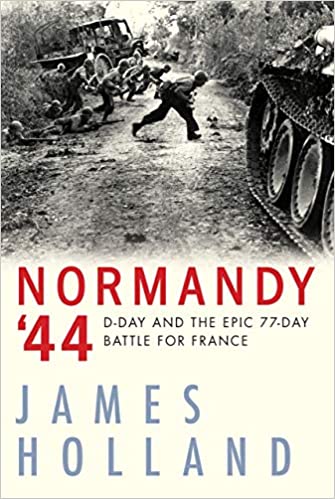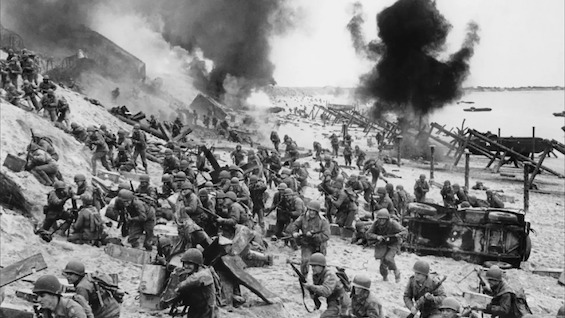
Estimated reading time: 11 minutes
History can deceive us. When we read about the major events of the past, they appear inevitable with all the black-and-white certainty of words on a page. And that’s certainly true about D-Day. The Allies had assembled such overwhelming force in June 1944 that it may seem they couldn’t possibly have failed to crash past the Nazi defenders in northern France and drive through to Germany. But of course that wasn’t the case at all. This is merely one of the many myths about D Day.
From the outset, D-Day and the bitter battle that ensued across Normandy was never a sure thing. In fact, a lot went wrong in the execution of Operation Overlord. And the invasion succeeded only because vastly more went awry in the Nazis’ response. The Germans suffered from “convoluted and muddle-headed command structures that had blighted their army ever since Hitler had taken direct command back in December 1941.” And that proved fatal. That’s the overarching lesson that emerges in James Holland’s brilliant survey of the landings and the 11-week-long battle that followed, Normandy ’44.
Reexamining the facts about D-Day and Normandy
Most of what we think we know about the Normandy Invasion comes from books written decades ago. For example, the National World War II Museum identifies the best single book on the subject as Russell E. Weigley’s Eisenhower’s Lieutenants, published in 1981. Others point to The Longest Day by Cornelius Ryan (1959) and Stephen Ambrose’s D-Day (1994) and Band of Brothers (1992). They’re all good books, and Ryan’s in particular benefits from the availability of so many veterans of the event barely more than a decade after it took place.
In the years since, however, once-top-secret files have been opened, and historians have dug deeply into the newly available sources and reexamined old ones. Holland’s 2020 book makes abundant use of all the insight and the hidden facts that have come to light from their work. The result is a balanced account that offers new perspective on D-Day and the Battle of Normandy. In the process, he debunks some of the many myths and misunderstandings that have gained a foothold over the years.
Normandy ’44: D-Day and the Epic 77-Day Battle for France by James Holland (2020) 864 pages ★★★★★

Eight myths and misunderstandings about D Day
As I look back on reading Normandy ’44, I identify no fewer than eight common myths and misunderstandings about the events that unfolded from June 6 to August 30, when the Battle of Normandy formally came to a close.
1. The invasion was risky and might have failed
Operation Overlord might well have foundered on the beaches if things had gone just a little differently. Among the many factors that could have stopped the Allied troops at the water’s edge two were most prominent. Eisenhower had gambled that the break in the weather his chief forecaster noted on June 5 would continue through the sixth. It might well not have done so. Other Allied forecasters predicted it wouldn’t.
And the Nazis’ failure to move quickly against the landings could easily have been corrected. But Hitler and his top generals in Germany were convinced that Normandy was just a feint, partly because the Pas de Calais seemed so much more logical a landing place, and partly because the Allies’ brilliant deception operations were so successful. The German high command insisted on keeping their most effective forces backstopping the Pas de Calais despite desperate pleas from Field Marshal Erwin Rommel to move the army’s strongest divisions westward. They continued to expect the “real” invasion for weeks after June 6.
2. Allied air and naval forces were as important to victory as the troops on the ground
Most accounts of the invasion focus on the 156,000 heroic soldiers who stormed the beaches or parachuted behind enemy lines on June 6. Holland acknowledges their courage and fighting skill. But he makes clear that the role of Allied air and naval forces was pivotal—and not just in landing 132,000 soldiers on the beaches and dropping 24,000 more from the air. The British Ninth Air Force, the US Army Eighth Air Force, the RAF, and the Royal Navy overwhelmed the Nazi defenders with withering bombardment from ships in the Channel and from the air.
In particular, “Air power was both absolutely vital to the planning of OVERLORD and rightly seen as key to the victory on the ground.” Many of the German divisions thrown against Allied troops were decimated and demoralized by the constant din and destruction. Allied soldiers could not have pulled off the invasion alone. Air and naval supremacy were decisive.
3. Airborne troops did land on and near their targets
Many things went wrong. But they were not necessarily those that later critics blamed on Eisenhower, Montgomery, and their officers on the ground. For example, it seems to have become a commonplace to believe that the US 82nd and 101st Airborne Divisions, the British 6th Airborne Division, and the 1st Canadian Parachute Battalion dropped far and wide across the Norman landscape, miles from their designated landing zones. Not true, Holland notes. “Historians have repeatedly painted a picture of paratroopers being spread to the four winds in a hopelessly disastrous air drop, and yet 50 per cent had landed within 1-2 miles of their [designated landing zones] and 75 per cent within 5 miles.” Their commanders couldn’t have hoped for anything better.
4. Eisenhower, Montgomery, and Bradley moved forward slowly for good reasons
Armchair generals, war critics at home, and some military historians have taken the leading Allied generals to task for advancing so slowly into Normandy. Of course, fierce Nazi resistance in many quarters played a role. But there was a bigger reason, Holland explains, “why the Allies rarely operated with lightning speed or with the kind of tactical agility for which the Germans were renowned, and this was largely down to the constraints of material wealth. The Allies had developed a method of beating the Germans that relied heavily on fire-power and a huge number of support personnel, and which also ensured that the number of men at the coal-face of battle was, in the big scheme of things, comparatively small. Infantry, for example, made up just 14 per cent of the British and Canadian Army servicemen in Normandy, and armour even less.”
Holland adds, “The Red Army and the Wehrmacht were proof of how inefficient and costly it was to have so many front-line divisions; it was why their wartime casualties were so much higher, even though the global effort in both Britain and the United States in the war so far had been [proportionately] far greater than that of the Soviet Union.”
5. The vaunted fanatical Nazi troops weren’t so fearsome after all
Most accounts of the fighting in Normandy emphasize the fearsome fighting strength of the Nazi forces and the intimidating design of the Atlantic Wall facing the Allies. In fact, however, the Normandy beaches were thinly defended at first. The frontline divisions facing Allied soldiers on June 6 were depleted in strength, undertrained, lacking needed supplies, and consisted mostly of second-rate troops. That changed as the Nazis slowly moved powerful SS and Panzer divisions westward from the Pas de Calais. There were ten German divisions in northern France that were truly formidable. But even those vaunted fighting forces proved to be less intimidating than the fanatical Nazi fighting machines the Allies had envisioned. Air and naval bombardment mercilessly cut them down, and US, British, and Canadian troops bested them in the field.
6. Nazi weaponry was not superior to that of the Allies
Nazi tanks, artillery, and small arms were not superior to those of the Allies, Holland insists. In a lengthy and detailed comparison of the tanks, artillery, rifles, and pistols wielded by the contending armies, he makes clear that the two sides were equally matched. For example, the vaunted Tiger and Panther tanks that often spearheaded Nazi attacks were mechanically so complicated that they frequently broke down in the field and were rendered useless. They also guzzled gas at a stupendous rate, a huge handicap for the fuel-strapped Nazis.
The lighter, more agile, and far more dependable Shermans manufactured by the Americans proved superior in the long run. British Churchill tanks, too, demonstrated an ability to climb steep inclines despite their great weight, a huge advantage in the rugged bocage of Normandy. And the flame-throwing British Crocodile tank quickly established itself as the most frightening weapon of the battle, judging from testimony by Nazi prisoners.
7. Casualties on Omaha Beach paled beside those of later stages in the battle
Nearly every account of Operation Overlord emphasizes the horrific losses suffered by the US First and 29th Divisions on Omaha Beach. It was, of course, tragic. More than 4,400 American soldiers lost their lives there. And the fighting was touch and go at first. However, casualties among the 156,000 troops who landed on June 6 were far lower than Eisenhower, Montgomery, and their planning staffs had anticipated. The truly tragic losses came later. Holland observes, “When attacking it was easy for both infantry and armour to take truly appalling numbers of casualties very quickly, and among those parts of the army casualties were proportionately every bit as high, and frequently higher, than they had been on the Western Front in 1914-18.”
For example, in one operation, “the lead elements of an attacking [Allied] infantry division had, in fact, been whittled down to about 2,000 men [from] 5,400. . . The same principle applied to the armored regiment, so that instead of having 150 tanks in support there would be more like 80.” Overall, “The Allies lost some 209,000 casualties out of over 2 million brought across the Channel . . . [which] amounts to a daily casualty rate of around 6,870, worse than the Somme, Passchendaele and Verdun in the First World War, three battles usually viewed as a benchmark for wanton slaughter.”
8. D-Day wasn’t even close to the largest military operation of World War II
Historians and novelists alike have paid so much attention to the Normandy Invasion that most Americans assume it was the largest military operation of World War II. True enough, it was massive. From January to June 1944, nine million tons of supplies and 800,000 men crossed the Atlantic from the United States to bulk up the invading forces. 7,000 Allied ships and 12,000 aircraft took part in the 11-week battle, and eventually two million troops arrived in Normandy.
However, operations on the Eastern Front were even more massive. Both the Germans and the Soviets launched much bigger attacks. Operation Barbarossa, the Nazi invasion of the USSR, involved some 3.8 million German and other Axis soldiers, including some 10 percent of the male population of Nazi Germany. And Operation Bagration, which the Russians launched two weeks after the Normandy landings against the Nazis’ Army Group Center, involved 2.5 million soldiers in 166 divisions. They caused the greatest defeat in German military history, with around 450,000 German casualties.
A focus on the men who did the fighting
Unavoidably, Holland weaves through his account the experiences of the generals, air marshals, and the admiral who planned and managed Operation Overlord and the battles that followed. But he focuses on the junior officers—the lieutenants, captains, and majors and their equivalent in the Wehrmacht and SS—who were in the thick of the fighting. A dozen or so of these men crop up at intervals throughout the book, bringing the reader’s view down from 30,000 feet to the often limited field of vision on the ground. It’s a lively and effective approach.
However, Holland’s book is no literary masterpiece. The writing style is flat and undistinguished. Normandy ’44 is a treasure chest of insight and detail nonetheless. It will delight any reader who wishes to understand one of the pivotal battles of World War II.
About the author

James Holland has written 13 nonfiction books about World War II for adults and eight for children as well as seven novels for adults and two for young adults. He has also written and appeared in nearly two dozen documentaries for BBC Two and PBS, among other outlets. Holland was born in Salisbury, England, in 1970. He is married and has two children.
For related reading
This is one of the top 10 nonfiction books that changed my thinking.
Because I often felt confused when the author referred by name to unfamiliar German or English military ranks, I prepared a guide to see at a glance how the ranks in one military service compared to those in another. You can find that guide at Comparing MIlitary Ranks in World War II.
For a far less readable account of these events, see D-Day: The Battle for Normandy by Antony Beevor (D-Day and Normandy viewed from the ground).
You’ll find other great books about the Second World War at:
- 10 top nonfiction books about World War II
- The 10 best novels about World War II
- 15 good books about the Holocaust
- 7 common misconceptions about World War II
- The 10 most consequential events of World War II
And you can always find my most popular reviews, and the most recent ones, on the Home Page.


























Excellent summary of what is a fascinating book. Glad you warned of its flat style though. Dr. Shelburne, Dad’s best friend, who had an upper-mid level position in the invasion planning would speak of the very sited elements mentioned in your review. He’d make the same points the author did, adding that the much more effective communications the Allies had vs. the Germans also contributed to the victory.
Thanks, Lee. Great to know. And I appreciate the mention of communications. I don’t recall seeing that in the book.